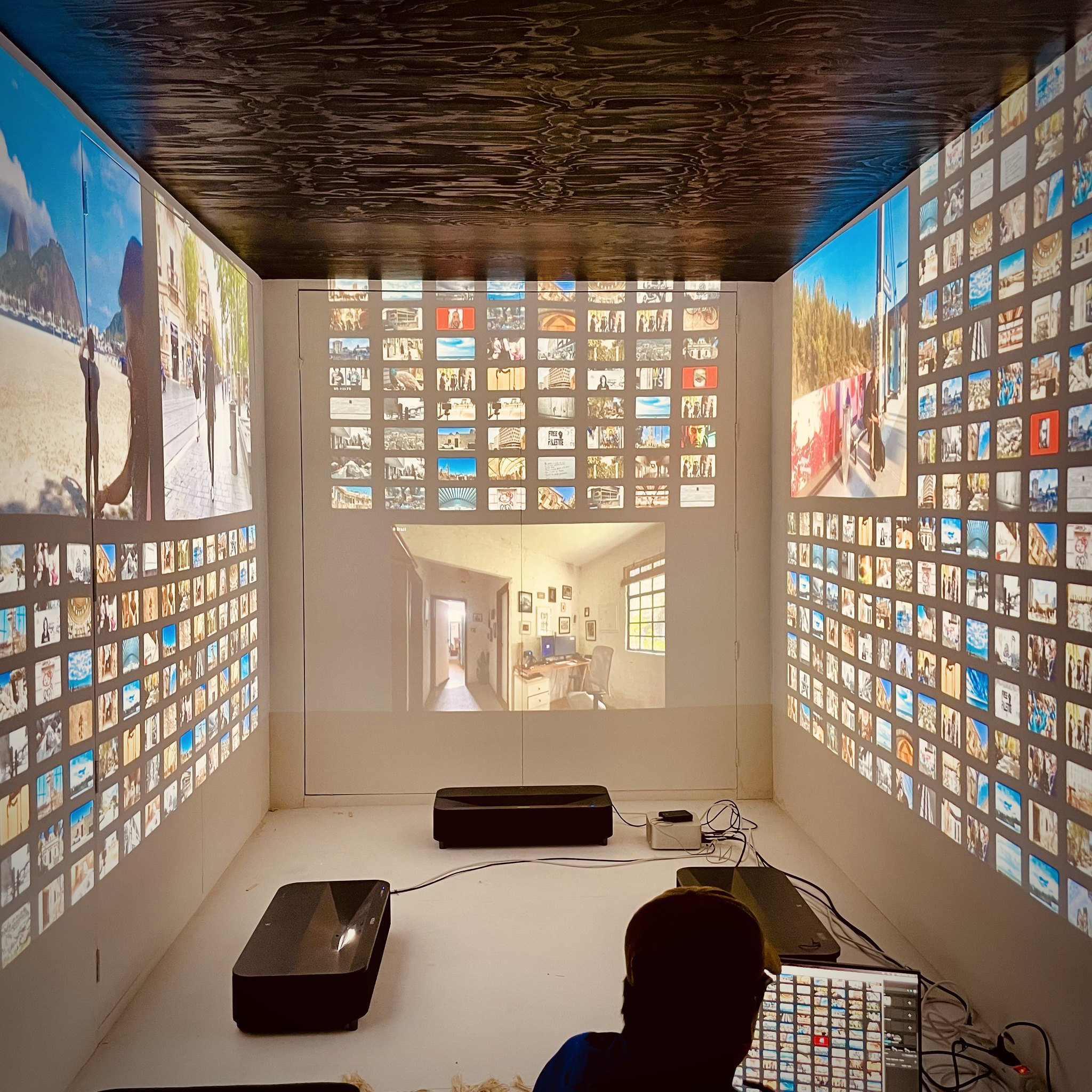In which I go for a walk, is an installation piece by Babak Fakhamzadeh created to be displayed on three internal walls of a shipping container.
This walking piece is one of the shortlisted pieces in the Marŝarto Awards 2023. However, because Babak is also co-founder of walk · listen · create, this piece is listed out-of-competition. Here, Babak discuss his work.
I had the fortune to be commissioned to put together an installation piece for iMKonsthall, an ambitious creative space in the far north of Sweden, just below the polar circle. The commission involved a four-week on-site residency, shared with several of the dozens of artists participating throughout the project’s period, spanning parts of 2022 and 2023.
For all participating artists, the produced work needed to be designed for consumption inside a traveling shipping container, the kind you see on the backs of trucks, or stacked on top of each other on large container ships, where the container would travel the Swedish countryside, bringing ‘art’ to the people.
The piece could be interactive, even with the help of immersive head-mounted displays, but was required to be situated within the container, meaning that the dynamics I would have at my disposal were somewhat limited.
Because my work often builds on the interaction between the individual and the built environment, this was an interesting limitation, which I overcame by making the piece itself immersive, ever-changing, while creating ‘windows’ into the world for viewers to ‘look’ through.
I’m based in Brazil, and my journey to northern Sweden became an integral part of the work itself. In all my stopovers, in South America, Europe, and the Middle East, I filmed myself walking. Stringing 60, or so, videos together, but such that every single ‘loop’ is different, the work creates the impression that I’m walking to northern Sweden, to the shipping container itself, from my home in Brazil, and back.
The videos are projected, as a kind of collage, on three of the walls of the shipping container, mixed with a palette of images taken on the journey to northern Sweden. At all times, several videos are playing at the same time, but I’m always only visible in one of the videos, the videos starting and stopping at just the right times for me to be always visible in one of the videos, with the audio, mixed into one feed, a palimpsest of sounds.
The resulting piece isn’t only accessible inside the Swedish shipping container. A web-based version is available for any sized screen.

Besides the dynamic version of the piece, I also put together a standalone, ‘fixed’, video that is available on YouTube, a YouTube playlist, a booklet, and more. I also used this project to experiment with using AI audio and image generation to augment my own content, something which I’ve now extensively built on in other projects, including Placecloud, as well as commercial, commissioned, work.
The individual videos in the piece vary in length, but most are between 30 and 45 minutes. At any given time, multiple videos replay a fairly static scene from about as many countries. Part of my intention was that the videos draw the viewer’s focus to the few individuals that move through the scene, and to generate a sense of the viewer performing a role akin to a voyeur. In turn, I hope that that triggers the realisation that not only, in today’s world, we we ourselves are all always watched, but also that there is so much more for us to notice in the world around us, and that, through that, we can move through public space while being much more aware of how public space influences us, putting agency back where it should be, with ourselves.
If this objective sounds vaguely familiar, it’s because it’s influenced by the ideas of the Situationists, from whom I take more than a little inspiration in my work.
But what of the intended recipients? That is, the Swedes who are to experience the work inside the traveling shipping container? As the container is intended to travel the Swedish countryside, most of these viewers will not be nearly as affected by the changes in society the Situationists identified, and which more recent surveillance capitalism has exasperated.
Yet, after the privatisation of the public space, from the end of the Second World War onwards, the privatisation of personal space, roughly dovetailing with the rise of ad-based digital services, affects everyone, and along similar lines. Meaning that this work can serve both as an introduction to understanding how we, as individuals, are manipulated when moving through public space, as well as how our consumption has changed of content within personal space, in the form of the privatised feeds we scroll through on our phones and tablets.
At the same time, In which I go for a walk also aspires to simply be a piece that provides entertainment. The full running time of the dynamic version of the work is about 6 hours, and provides a continuously changing feed of events of everyday life from a few dozen places around the world. The YouTube playlist runs for about 30 hours.
In that sense, this work channels products like WindowSwap, also pieces that fit the description of Slow Television, perhaps initiated with the recordings of hours-long train journeys on nighttime German television in the 1990s, and the niche that is walking videos, like the ones from this YouTuber.
That is to say that I intend for this work to function on multiple levels, each equally appropriate.
The nature of the work is such that it could be extended indefinitely, as well as augmented with recordings that do not include myself at all, but that enrich the experience for the viewer with additional scenes from all over the world, perhaps constructing a kind of dynamic Where’s Wally.
But, I suppose, these are ideas for a future commission.
The winners and honourable mentions of the Marŝarto Awards 2023 will be announced in February 2024.


